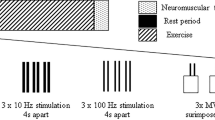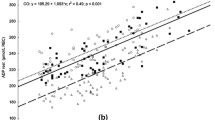Abstract
THE hydrolysis of ATP provides the energy source for muscular contraction. ATP is either stored in the muscle or produced by phosphorylation of ADP by creatine phosphate or glycolytic processes, or through oxidative processes in the mitochondria. The processes of adaptation which facilitate the glycolytic or oxidative production of ATP have been studied in trained and acutely exercised animals. After work has been done by the muscle, the oxidative1 and glycolytic2,3 capacities of its fibres increase. Christensen4 has shown that neither glycolysis nor oxidative processes take place during short anaerobic bursts of activity. The energy for such limited activities is provided by the hydrolysis of stored ATP and phosphorylation of ADP by creatine phosphate by the Lohman reaction. Previous exercise studies using endurance types of training have not shown any adaptation of either ATP or creatine phosphate5–7, although electrical stimulation8 and dwelling at high altitude9 have produced increases in creatine phosphate.
This is a preview of subscription content, access via your institution
Access options
Subscribe to this journal
Receive 51 print issues and online access
$199.00 per year
only $3.90 per issue
Buy this article
- Purchase on Springer Link
- Instant access to full article PDF
Prices may be subject to local taxes which are calculated during checkout
Similar content being viewed by others
References
Holloszy, J. O., J. Biol. Chem., 242, 2278 (1967).
Barnard, J., and Peter, J. B., J. Appl. Physiol., 27, 691 (1969).
Peter, J. B., Jefferson, R. N., and Lamb, D. R., Science, 160, 200 (1968).
Christensen, E. H., Hedman, R., and Salten, B., Acta Physiol. Scand., 50, 269 (1960).
Harris, J. W., Res. Quart., 38, 598 (1967).
Rulcker, C., Lundberg, P., and Lamek, N., Acta Vet. Scand., 8, 189 (1967).
Procter, H. A., and Best, C. H., Amer. J. Physiol., 100, 506 (1932).
Palladin, A., and Ferdmann, D., Z. Physiol. Chem., 174, 284 (1928).
Tappan, D. V., Reynafarje, D. B., Potter, V., and Hurtado, A., Amer. J. Physiol., 190, 93 (1957).
Lamprecht, W., and Trautschold, I., in Methods of Enzymatic Analysis (edit. by Bergmeyer, H. V.) (Academic Press, New York, 1963).
Edwards, A. L., Experimental Design in Psychological Research (Holt, Rinehart, and Winston, New York, 1950).
Hays, W. L., Statistics (Holt, Rinehart, and Winston, New York, 1963).
Romanul, F. C. A., Arch. Neurol., 11, 355 (1964).
Stein, J. M., and Padykula, H. A., Amer. J. Anat., 110, 103 (1962).
Author information
Authors and Affiliations
Rights and permissions
About this article
Cite this article
GALE, J., NAGLE, F. Changes in ATP and Creatine Phosphate Storage in Skeletal Muscle of Rats trained at 900 and 7,600 Feet. Nature 232, 342–343 (1971). https://doi.org/10.1038/232342a0
Received:
Revised:
Issue Date:
DOI: https://doi.org/10.1038/232342a0
This article is cited by
-
Effects of short-term, high intensity (Sprint) training on some contractile and metabolic characteristics of fast and slow muscle of the rat
Pfl�gers Archiv European Journal of Physiology (1973)
Comments
By submitting a comment you agree to abide by our Terms and Community Guidelines. If you find something abusive or that does not comply with our terms or guidelines please flag it as inappropriate.



